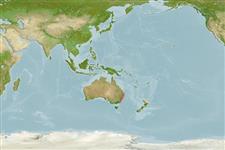Elasmobranchi (squali e razze) (sharks and rays) >
Myliobatiformes (Stingrays) >
Urolophidae (Round rays)
Etymology: Trygonoptera: Greek, trygon = a sting ray + Greek, pteron = wing, fin (Ref. 45335).
More on authors: Müller & Henle.
Environment: milieu / climate zone / depth range / distribution range
Ecologia
marino; salmastro demersale; distribuzione batimetrica ? - 135 m (Ref. 9863), usually ? - 60 m (Ref. 9863). Temperate; 26°S - 38°S
Western Pacific: southern Queensland to New South Wales.
Length at first maturity / Size / Peso / Age
Maturity: Lm ?, range 41 - 42.7 cm
Max length : 47.0 cm TL maschio/sesso non determinato; (Ref. 9863)
Found in sandy beaches and reefs but also well offshore. May venture well upstream in estuaries (Ref. 6871). Feeds on worms, crustaceans, bony fishes, and other stingarees (Ref. 12951).
Life cycle and mating behavior
Maturità | Riproduzione | Deposizione | Uova | Fecundity | Larve
Compagno, L.J.V., 1999. Checklist of living elasmobranchs. p. 471-498. In W.C. Hamlett (ed.) Sharks, skates, and rays: the biology of elasmobranch fishes. Johns Hopkins University Press, Maryland. (Ref. 35766)
IUCN Red List Status (Ref. 130435: Version 2024-1)
Threat to humans
Harmless
Human uses
Strumenti
Special reports
Download XML
Fonti Internet
Estimates based on models
Preferred temperature (Ref.
123201): 17.1 - 24.1, mean 18.2 °C (based on 40 cells).
Phylogenetic diversity index (Ref.
82804): PD
50 = 0.5156 [Uniqueness, from 0.5 = low to 2.0 = high].
Bayesian length-weight: a=0.00813 (0.00372 - 0.01775), b=3.08 (2.88 - 3.28), in cm total length, based on LWR estimates for this (Sub)family-body shape (Ref.
93245).
Trophic level (Ref.
69278): 3.8 ±0.59 se; based on food items.
Resilienza (Ref.
120179): Basso, tempo minimo di raddoppiamento della popolazione 4.5 - 14 anni (Assuming fecundity<100).
Fishing Vulnerability (Ref.
59153): Moderate vulnerability (37 of 100).
Nutrients (Ref.
124155): Calcium = 7.7 [1.1, 139.9] mg/100g; Iron = 0.255 [0.025, 2.936] mg/100g; Protein = 20.1 [14.8, 25.3] %; Omega3 = 0.43 [0.13, 1.30] g/100g; Selenium = 8.78 [1.70, 44.63] μg/100g; VitaminA = 9.32 [0.81, 102.75] μg/100g; Zinc = 0.528 [0.041, 5.686] mg/100g (wet weight);
